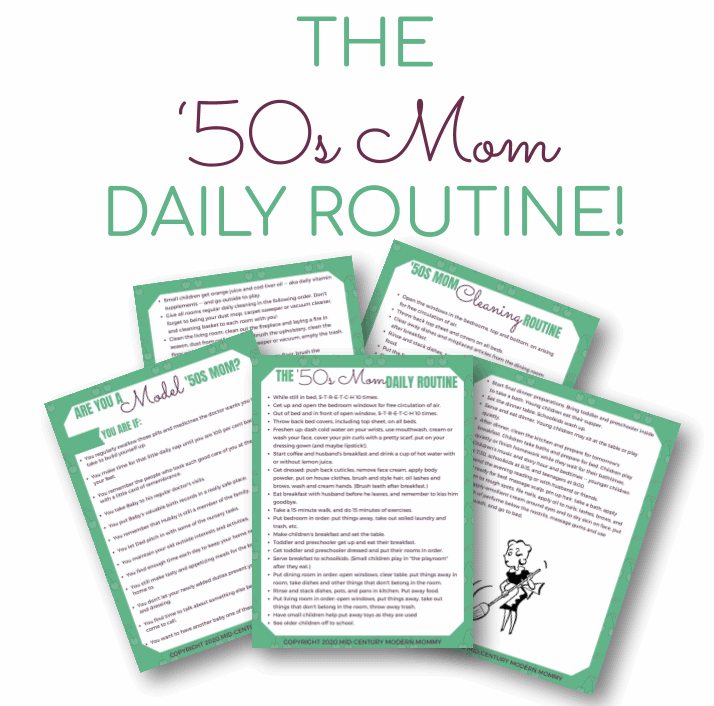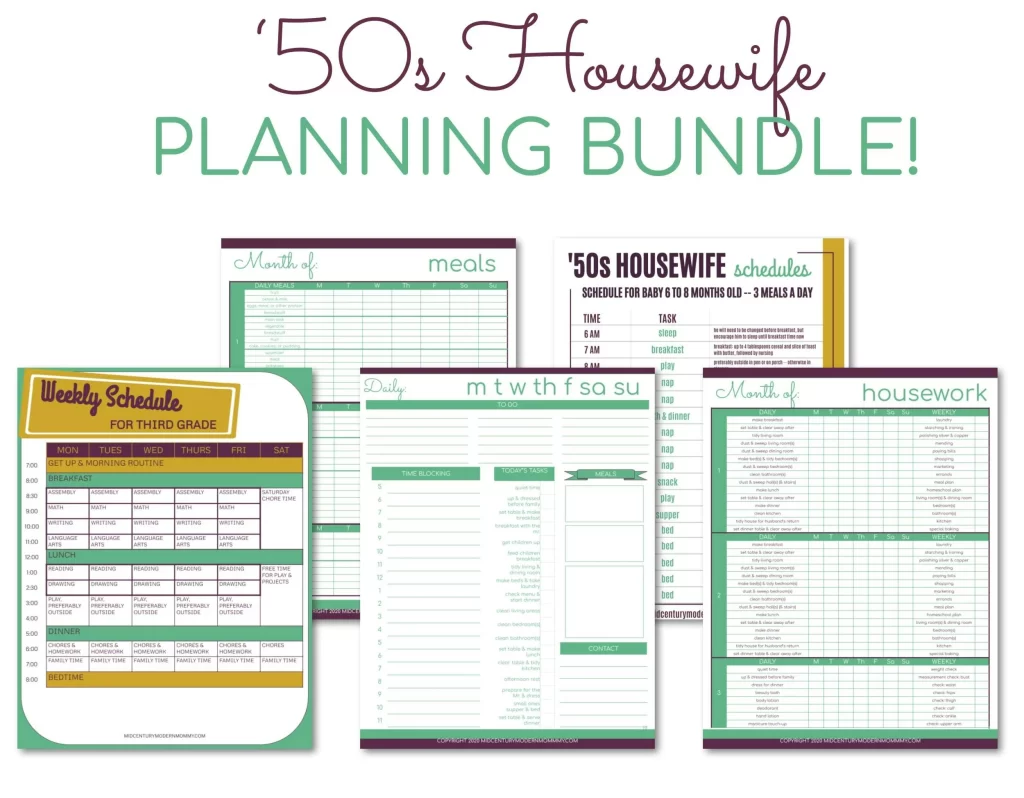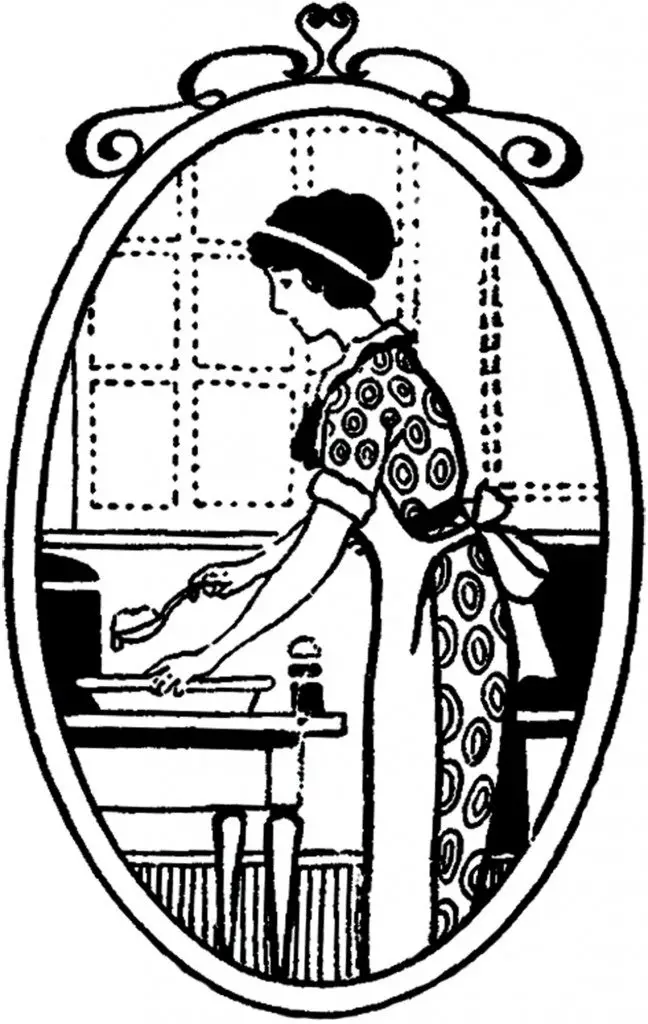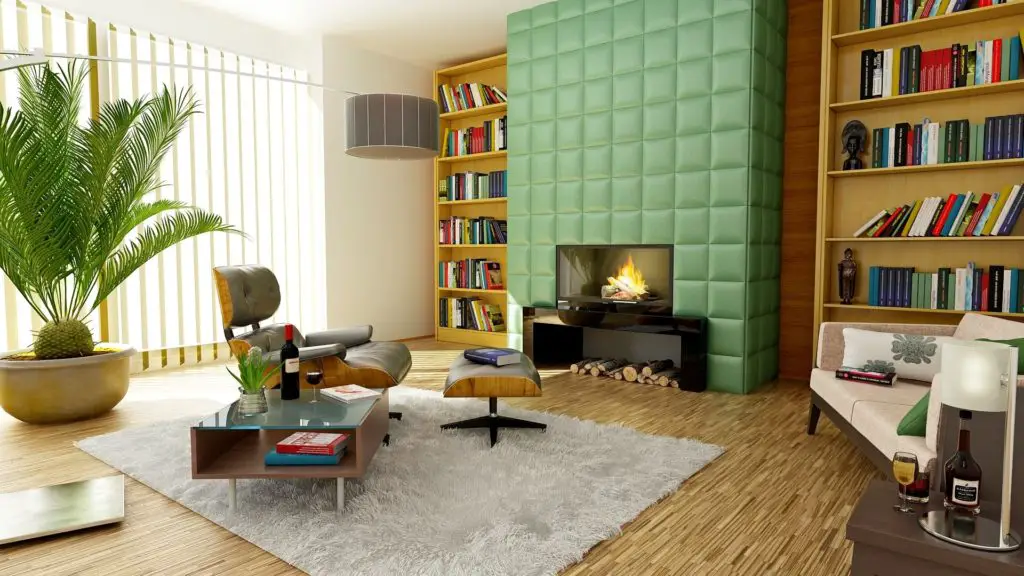In the 1950s, balancing work and home life was an art, especially for the housewife with a career–and it’s much the same now. But a well-curated wardrobe makes it EASY to seamlessly transition from breakfast at home to a professional setting and then back to an evening of hostessing or relaxation.
Vintage elegance can help you choose a vintage capsule wardrobe so you can embody the elegance and practicality of the era while embracing your own busy lifestyle. Here is a complete professional vintage wardrobe, piece by piece.

Get Our Mid-Century Mom Daily Routine FREE!
This post contains affiliate links. If you click a link and make a purchase, I may receive, at no additional cost to you, a small commission. Find out more on my Disclosures page, and thank you so much for your support!
Why You Need a Vintage Style Professional Wardrobe
So why do you need a vintage wardrobe as a professional?
Faced with inflation and an ever-shrinking dollar, the best clothing buys are those that last the longest. This may not always tally with what’s the latest in fashion, but it makes a wise investment. Think of all those elegant ladies who wear classic clothing. They pay little attention to fads and hemlines and collect only one or two new outfits a year.
This contrast always strikes me when I notice a well-dressed woman on the street or in a fine restaurant. And what does this woman look like? She is very well-groomed and dressed in a simple silk dress or well-cut suit. Her age and the age of her clothes are unimportant. What comes across is a feeling of elegance, of quality.
As American women learn to collect their clothes, to buy quality and not quantity, to look for the kinds of fashions that will remain in good taste for a long time, we too are more at ease with ourselves. And as the price of women’s clothing climbs, we are forced more and more to take this approach. A good working wardrobe is available to anyone who cares.
Capsule Wardrobes in Vintage Books
There are a lot of great vintage clothing and dress books out there.
One of the books I recommend to get an amazing understanding of the importance that proper clothing and dress had in the mid-20th century and before is The Lost Art of Dress by Linda Przybyszewski. This book tells the story of the “Dress Doctors,” home economists who worked through the Depression, World Wars, and social upheaval to help women dress attractively, appropriately, and economically.
This professional woman’s wardrobe is actually from a singularly successful professional woman — Edith Head. It is in her book, How to Dress for Success.
Some of my favorite vintage “Dress Doctors” books are:
- Individually Yours by Celeste Carlyle
- Wife Dressing, by Anne Fogarty
- Secrets of Charm, by John Robert Powers
- Harmony in Dress, by Woman’s Institute

Best Colors for a Vintage Professional Wardrobe
The ultimate vintage professional look is a navy blue suit.
Gray was acceptable, but only before 5. Black traditionally is only acceptable after 5 in the city — or for a funeral. (I don’t know what that says about the vintage opinion of city nightlife!)
Of course, if you weren’t in an executive-facing role, what you wore needed to be modest and discreet — but wearing professional attire STILL made you more likely to be moved out of the typing pool. And if you have a professional or trade uniform, you are set!
Accessories were generally black, tan, or oxblood. Gloves were usually dark — not white, except in summer. Crocodile and suede were considered informal and sporty — not a good look at the office!
Here is a table of color combination ideas from the 1920s you can try:

1950s Complete Vintage Career Wardrobe
This covers everything except accessories and underthings like foundation garments. To get that real vintage look, you need the right undergarments.

MORNING (Before work, at breakfast, etc.):
- 2 shifts or smocks or dusters or zipper-front step-ins or breakfast coats or robes
Getting dressed first thing is easier when you know exactly what to grab to get dressed in the morning. Shifts, smocks and dusters were all loose, trapeeze-shape garments, usually with snaps or zippers on the front. Zip-front step-ins were siren suits or short-alls with a zipper on the front. Breakfast coats and robes were fancier, fitted, and in luxurious fabrics, but the goal was the same.
The point of all these garments was that they would slip over your underthings–your lingerie and foundation garments, so that you could get your morning chores done without putting your good work clothes on.
AT WORK (When no specific costume is required):
- 2 suits
- 6 tops-blouses or shells or sweaters
- 2 day dresses (1-piece, or 2-piece or jumper-type) and a separate jacket or cardigan
- 2 skirts to be worn with the jacket or sweater and blouses from above
- 1 coat
Edith Head says repeatedly that the way to make clothing work well in a budget is to create wardrobes of interchangeable pieces.
If your 2 suits are navy and gray (castor on the color combinations table!), they can both work with white, delft blue, raspberry pink, and mignonette green for tops, and gold for jewelry. Terra cotta is mentioned, so they would work with the oxblood leather shoes, bag, and gloves, and fawn is mentioned, so tan leather will also work.
This method of color planning should be combined with also making note of the best shapes and silhouettes for your figure.

AFTER WORK (with time to go home for a change):
- 1 costume (1-piece or 2-piece dress) and a jacket or wrap
- 1 cocktail or short dinner dress (try to use the wrap from above)
- 1 dressmaker or cocktail suit, with three changes of tops (knit, lace, crepe, matching fabric or brocade)
- 1 coat (unless you can use the coat from the costume above)
These should be dressier fabrics than the daytime wear. The tops in particular should be quite fancy.
The cocktail dress is shorter and is good as a super simple design in a black wool crepe for your quintessential little black dress. The costume can be a long dinner dress and matching evening coat in a bright color and rich material to maximize interchangeable use.
If you didn’t have time to go home for a change, Edith Head mentions that you could still take a dressy evening top and accessories in your bag to get ready for an evening out.
AT HOME (entertaining):
- 1 hostess gown or hostess pajamas
- 1 at-home skirt or pants, more if you’re married-with extra interchangeable tops.
- 3 tops for above-blouses or shells or pullover sweaters. These can be the same as your after-work tops.
- 2 dresses-1-piece or 2-piece (for informal entertaining)
As you can see, this calls for extra dressy at-home outfits if you are married. The idea was that you would wear these things for your husband as much as for other company, since he was presumably at least as important to you as your guests were! But! You could also wear luxurious-but-comfortable and stylish hostess pajamas, which could look and feel quite nice.
AT HOME (Not entertaining):
- 1 housecoat or slip-on
- 1 lounging pajamas and top, or pants and top
Even for being a single lady at home, beautiful clothes were prescribed to make you feel good about yourself.
FORMAL WEAR:
- 1 informal or semi-formal costume This can be a dress and wrap or a dress and coat. It can be the same dinner dress you use for entertaining at home. If this is a 2-piece dress, get alternate tops which are great wardrobe stretchers.
- 1 formal evening dress and wrap, if you have use for it. (If not, get two semi-formal costumes)
Even formal wear could be used interchangeably, which hearkens to the old WASP idea of dressing nicely every day, but dressing discreetly for fancy and formal occasions, rather than being showy.

Minimum Vintage Underwear Checklist
There is a social media trend of showing the shapewear and underwear for your vintage outfit in your GWRM (Get Ready With Me) videos. This trend is a far cry from never letting your slip show, but it does help modern housewives understand what to wear under those gorgeous outfits.
Always wear the underwear and shapewear that you intend for the outfit when you are fitting it, either in the store or sewing.
Never go shopping underdressed, or your clothes won’t fit or look right when you try them on “with all the trimmings.” The proper underthings for a vintage outfit are girdle and bra or corset or merry widow (shapewear), then panties and slip (underwear), and stockings. All of these need to be changed every day, sometimes more than once for freshness.
All your underthings should be washed out daily and allowed to rest 24 hours before wearing again, so it helps to have more than 1 of each.
- 6 pairs of stockings
- 2 light-colored girdles
- 1 dark-colored girdles
- 2 light colored bras
- 1 dark-colored bra
- 2 light-colored full slips
- 1 dark-colored full slip
- 2 light colored half slips
- 1 dark colored half slip
- 6 pairs of panties
Clothes for Housework
Part of your unmentionables is your “at-home” wear. Vintage pattern companies and clothing companies included sturdy overall dresses, dusters, and wrap dresses known as bungalow aprons in their lingerie collections for doing the housework.
Housework clothes should always be cotton and easily washable, and for a professional wardrobe, look for styles that can slip over other clothes to protect them.
- 4 wrap-around or overall aprons for housework, with matching hair scarves
- 4 kitchen aprons with matching oven mitts
Vintage Sleepwear
Part of a proper vintage wardrobe is considering your sleepwear. If you have a husband, you may want to double this, and put extra thought into what you get!
Boudoir caps are NOT to cover a porcupine-like halo of curlers. But it does work well to cover the new heatless curlers (which are really just old-fashioned rag curlers) and still look pretty for bedtime. Never go to bed looking like a fright.
Keep your dressing gown and slippers near your bed so that you can slip into them on your way to the dressing table or lavatory sink when you do your morning and evening beauty routines.
- 3 nightgowns with matching bed jackets and boudoir caps
- 1 dressing gown
- 1 pair of matching slippers
Vintage Accessories
Although hats are not mentioned, you may want a professional-looking daytime hat, or a go-to hairstyle, so that you can look neat. Hats should always match the dress or suit, not the coat, since the coat will presumably be removed.
Edith Head suggests a woman, whether a working girl or a housewife, have 2 pairs of day shoes, one pair of dress shoes, 2 day purses, and 1 evening purse. And at least 2 day hats and 1 afternoon or dress-up hat.
Jewelry is very personal and is also sorted into 2 categories. For the day, plain jewelry. Evening jewelry can be glitter or pearls.
Scarves are very important because they can easily change the look of a suit or costume. If they make you happy, use them!
A need for rainwear and umbrellas naturally depends upon your locale and how much you would use them. The same with sportswear — always have the necessary clothing and equipment for sports that you *do*.
Of course, spectator sports involves choosing from a wardrobe of casual separates, such as skirts, slacks, and sweaters. Think the traditional 1950s college student look. The number of these that you need depends on how often you use them.

Resources
How to Dress For Success, Edith Head
Elegance, Genevieve Antoine-Dariaux
Harmony in Dress, Women’s Institute

Get Our Mid-Century Mom Daily Routine FREE!




